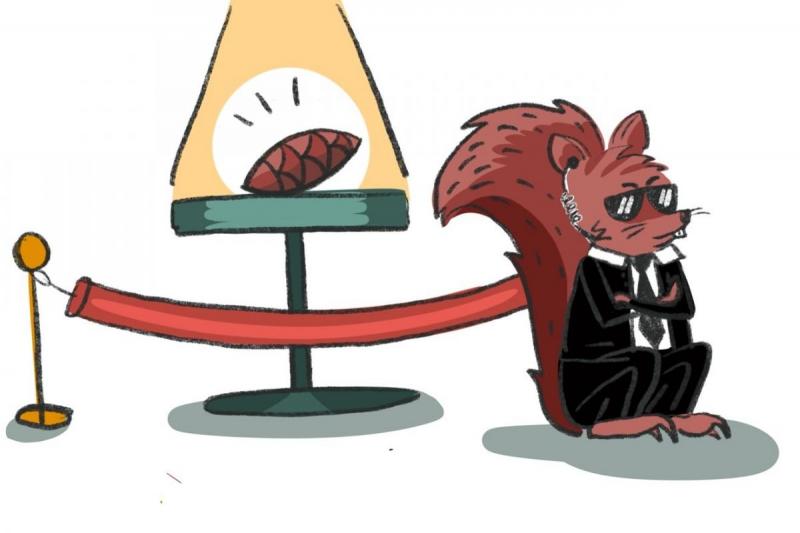When Squirrels Win the Spruce Cone Lottery, They Stop Shouting “Get Off My Lawn!”
By Shelby Bohn
23 January 2023

Illustration by Shelby Bohn
Imagine if grocery stores were only open for a few months every five years, and the rest of the time you had to depend on food stored in your basement. For North American red squirrels in the Yukon’s Kluane (pronounced clue-AW-knee) National Forest, this is a more familiar scenario than you might expect.
North American red squirrels specialize on the cones of surrounding white spruce trees. In an average year, these trees don’t produce very many cones, but once every 4-6 years, they produce a “cone-anza” that scientists call a mast crop.
Generally, masting species like white spruce don’t tend to have their own seed-eating specialists, because it’s difficult to survive exclusively on this all-or-none menu. Red squirrels are unique, however, because they can pack up the leftovers from their mast crop to store for later.
But just like you have to write your name on any food you put in the office fridge, red squirrels are considered territorial because they defend their cones from hungry thieves.
“Territoriality is really interesting,” says Dr. Quinn Webber, an assistant professor in the Department of Integrative Biology.
“In order to defend something, there has to be another animal to defend against. As a behavioural ecologist, one of my big research interests is understanding how both social and spatial behaviour impact animal health and survival.”
If you’ve ever stumbled onto a squirrel’s territory while out on a hike, chances are they let you know! These territorial sounds are called “rattles” and are the main way that squirrels defend their territories from intruders.
“With red squirrels, it’s difficult to directly observe social interactions because they don’t hang out in groups, so we had to get a little bit creative,” says Webber.
During his time as a post-doctoral fellow at the University of Colorado, Webber tapped into 30 years of data collected by collaborators involved with the long-running Kluane Red Squirrel Project. These data included recorded rattles and instances of attempted cone-theft from neighbouring squirrels.
Webber used the information to create a map that tells him which squirrels had territorial interactions and where they happened, a method called social network analysis. The study, recently published in the Journal of Animal Ecology, is the first time that this approach has been used to study territoriality in squirrels.
“Social network analysis is a really powerful tool, and no one’s ever used it this way before, so I was excited that it worked well for our data.”
Webber and his co-authors found that while squirrels are usually territorial, there is some flexibility in how strictly they enforce these territories.
“The influx of food during a mast year really affects territoriality, which was somewhat of an unknown until now,” explains Webber.
The all-you-can-cache cone buffet during mast years means there are enough cones that the squirrels don’t need to steal them from others, but it also means there are so many cones that it would be impossible to defend them all from other squirrels even if they tried. During mast years, squirrels had very small territories, which meant they weren’t defending as much real estate from their neighbours.
More food during mast years also means higher survival of offspring, and therefore even more squirrels the next year. This makes red squirrels a rare example of an animal that actually becomes less territorial at a higher population density.
Population density is interesting to Webber because of the “One Health” approach he takes to his research.
“One health is the intersection of human health, environmental health, and animal health. My work is generally on the animal health side of things, but it has implications for humans and environmental health as well.”
Webber, who joined the University of Guelph in 2022, looks forward to exploring these interwoven topics as he grows his newly established research program.
“I’m really excited to explore these types of questions in other systems, especially caribou and bats, to understand how social and spatial behaviour affect things like survival and parasitism.”
This study was funded by a Banting Post-Doctoral Fellowship, the Natural Science Engineering Research Council (NSERC), Northern Scientific Training Program (NSTP), and the USA National Science Foundation (NSF).
Read the full study in the Journal of Animal Ecology.
Read about other CBS Research Highlights.